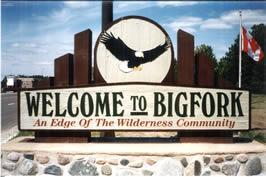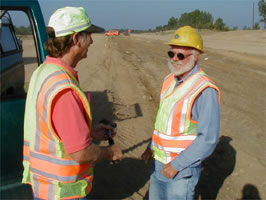 |
This sign depicting the Edge of the Wilderness Scenic Byway's logo
welcomes travelers to Bigfork along Hwy 38 between Grand Rapids and
Effie. Photo by John Bray
|
Minnesota music icon Bob Dylan wrote songs about Hwy 61, Dinkytownís Fourth
Street and walking down dirt roads, but now he has to share some songwriting
credit about the stateís roads with two newcomers.
One, syndicated outdoors journalist Ron Schara, penned "The Ballad of
Highway 38," a song about the road that winds it way through the northern
forests between Grand Rapids and Effie, the route now designated as the Edge
of the Wilderness Scenic Byway.
In the north of Minnesota,
Thereís a roadway through the pines;
It rambles though wild country,
By lakes and creeks it winds.
Only 47 miles of magical trails,
Itís only one of a kind;
Goes right or left but never straight,
Thatís Highway 38.
And then thereís an updated version of "The Yellow Brick Road" from
the Wizard of Oz sponsored by the Spicer Commercial Club. The radio jingle encourages
tourists and other travelers to take heart and not fear visiting New London
and Spicer where Mn/DOT is busy rebuilding Hwy 23.
In the jingle, Dorothy, the Tin Man, the Lion and the Scarecrow try to figure
out how to reach the two cities. Approaching the Good Witch of the Road, the
Scarecrow laments, "If I only had brain, I could figure out a way to get
from here to there."
Soothingly, the witch tells him, "Itís still easy to get to your favorite
spots. Just hop in the car, tap the steering wheel three times and say, ĎThereís
no place like New London/Spicier.í"
So far, the campaign, which also includes billboards, has worked well, said
Dave Baker, president of the Spicer Commercial Club.
 |
Jim Christensen, project manager, and Dick Lindahl, a project inspector,
Willmar/District 8, confer about the progress of rebuilding Hwy 23 at
a site west of Spicer. Photo by Paul Jurek
|
A hotel and restaurant owner, Baker said his restaurant enjoyed its best ever
July, thanks in part to the campaign and the Mn/DOT construction teamís efforts
to keep traffic disruptions in Spicer at a minimum.
Jean Spaulding, Spicerís economic development director, said the Willmar/District
8 project staff has worked closely with the city to keep homes and businesses
accessible during construction.
"The Willmar people helped us hold our annual Fourth of July parade and
street dance and to create parking for 5,000 people even though the usual parade
route was under construction and heavy rain created minor floods and muddy conditions,"
she said. "We have a great working relationship."
Traffic disruption is rarely an issue on Hwy 38 in the sparsely populated north
of Grand Rapids, but respect for the natural environment ranks high.
Scharaís song, written in 1997, reflects that concern as well as the regionís
rich sense of history and tradition.
Hwy 38 from Grand Rapids to Marcell was designated as the Edge of the Wilderness
Scenic Byway in 1992; it earned national byway status in 1996. The designation
reflects Duluth/ District 1ís plan to rebuild the highway while keeping its
scenic, meandering nature.
Thereís a story about this famous
path where history comes alive;
with logging camps and trappersí
shacks that struggled to survive.
Thatís why today some folks live from
Effie to Grand Rapids;
They follow their hearts and trust
their fate to Highway 38.
Tim Johnson, community coordinator for the Highway 38 Leadership Board in Marcell,
said the song has been performed many times since Schara composed it in 1997.
The song was used to welcome visiting dignitaries and at community festivals
and celebrations in the region.
Johnson said "Highway 38" will receive a lot more play next year
when rebuilding work resumes on parts of the road to improve its safety and
driveability.
"Until John Bray, special assistant to the district engineer, sent us
an mp-3 version of the song, all we had was a tape recording from the radio,"
he said.
"Now anyone who wants to can hear it our on our Web site."
To hear the digitized, mp-3 version, visit the Edge of the Wilderness Web site
at: www.scenicbyway.com/.
By Craig Wilkins
|



